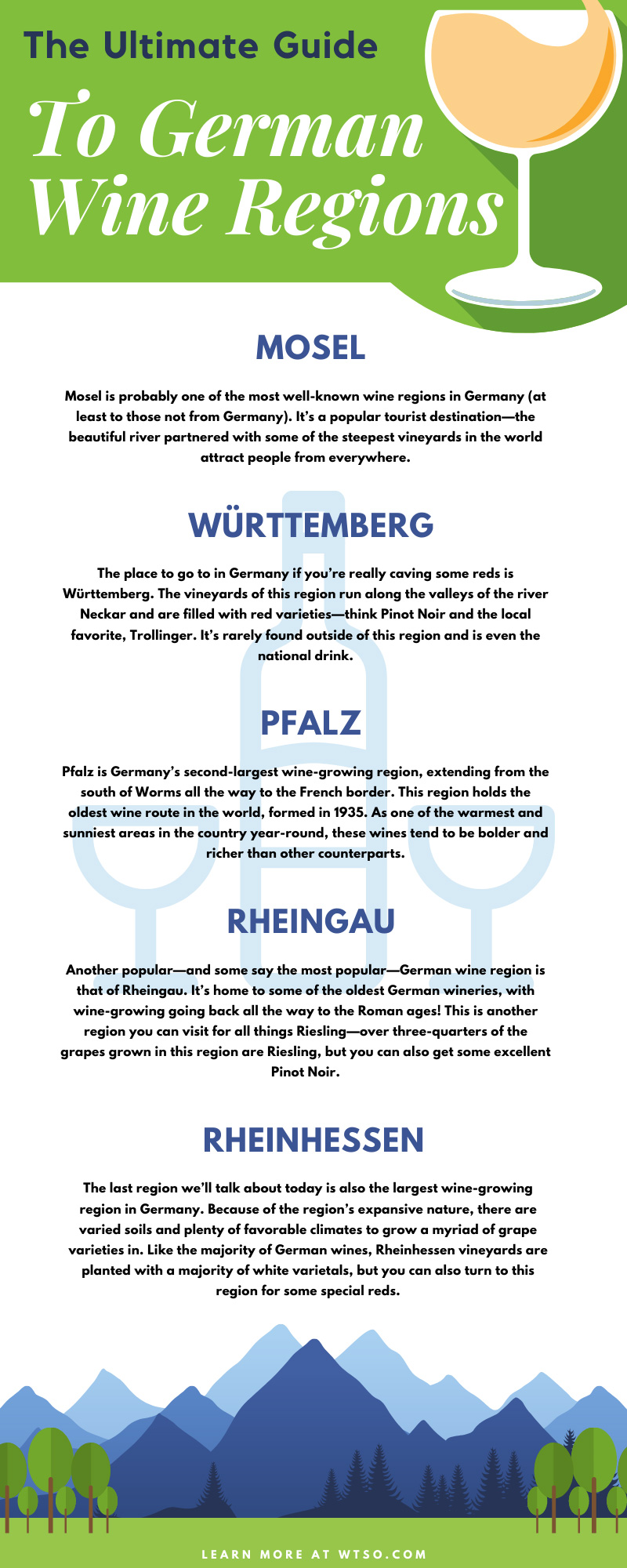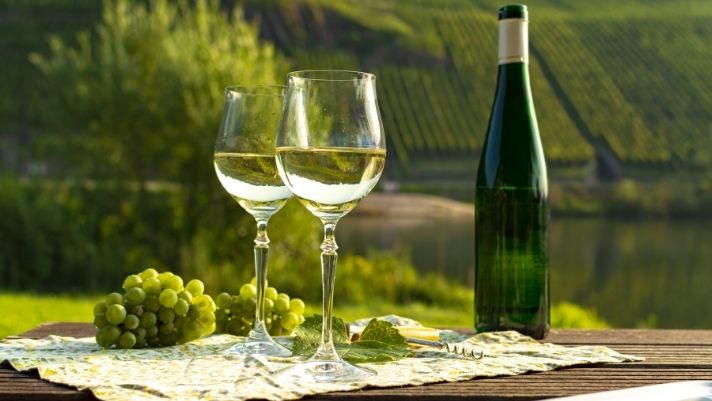Oktoberfest looked different this year. It was drinking Oktoberfest beers in the home and raising steins to family members rather than strangers—or, maybe you just didn’t participate at all. Well, even though the time has passed for beer, we figured that this was a good time to educate on the other libations of Germany—their delicious wines!
Most people don’t often think about German wine, but that’s a mistake that won’t happen again after learning more about German wines and all their distinct flavors. Dig into this underrated wine world with our ultimate guide to German wine regions. We’ll give you all the essential details so that when you can actually head to Germany, you’ll know just where to go. Check it out!
What Makes German Wine So Great?
Climate and Topography
A lot of what makes wine great is the landscape the grapes are grown in. In Germany, wine grapes get a cooler climate and a typically hilly topography—especially in the German countryside. Seeing as how that accounts for more than three-quarters of the country’s wine production, you can expect some well cared for grapes. But what you get with a cool climate and a hilly landscape is some inconsistent weather. This means that wines can vary from winery to winery and vintage to vintage.
If you visit in the future, visit different wineries in different locales and experience the beautiful variety of wine. Plus, you can soak up the stellar views!
Glorious Grapes
Speaking of grapes, Germany has some pretty special ones. Riesling is Germany’s number one planter. However, as we talked about above, just because it’s planted everywhere doesn’t mean the taste will be the same across the board. But, in addition, there’s also Pinot blanc (Weissburgunder), Pinot Gris (Grauburgunder), Müller Thurgau, and Pinot Noir. Don’t simply opt for Riesling; try something new, too.
Ripeness Designations for Prädikatsweine
Among German wines, Prädikatsweine are a collection of Prädikats or ‘distinctions’ given to wines based on their must weight – an indicator of grapes’ ripeness and sugar levels/potential alcohol at harvest. Grapes with more sugar can become wines with higher alcohol and/or sweetness. There are 6 Prädikat levels in German wine. Learn more about a few of them below.
Kabinett
Wines labeled Kabinett come from grapes with the lowest minimum must weight or in terms of sweetness, about 148–188 g/L of sugar. Typically, they’re low in alcohol (light-bodied) with a wonderfully crisp acidity and may be dry, off-dry, or even sometimes sweeter in style.
Spätlese
Spätlese, or “late harvest” wines come from grapes with a higher minimum must weight than Kabinett wines, translating to around 172–209 g/L of sugar. These wines usually feel fuller on the palate compared to Kabinett and typically offer some sweetness. If you see “Trocken” stated on a bottle of Spätlese wine, keep in mind that it will be dry in style with higher alcohol content and often of fine quality.
Auslese
Auslese, or “selected harvest” wines showcase hand-picked grapes with an even higher minimum must weight than Spätlese wines (191–260 g/L of sugar). These grapes are often affected by botrytis, or noble rot (a beneficial form of a grey fungus that dehydrates grapes, thereby concentrating their flavors and sugars). Auslese wines are usually rich and sweet in style with the capacity to age over long periods of time.
Eiswein
Incredibly rare and noble, Eiswein requires just the right circumstances to be produced. Grapes are required to have a minimum must weight that includes at least 260 g/L of sugar to become this lusciously sweet nectar, but weather conditions also need to freeze them on the vine. Growers have to hurry when this happens so they can pick and press the still frozen grapes, resulting in scarce dessert-style wines typically with the highest acidity among all the Prädikat levels. Eiswein’s best bottles can be cellared for decades and are one of the great joys that life has to offer!
5 Key Wine Regions
Now, here is some information on five key wine regions in Germany. Keep in mind that there are 13 in total, but these are some of our favorites and some of the most influential!
Mosel
Mosel is probably one of the most well-known wine regions in Germany (at least to those not from Germany). It’s a popular tourist destination—the beautiful river partnered with some of the steepest vineyards in the world attract people from everywhere. Come here for tasty Rieslings with balanced acidity and minerality.
Württemberg
The place to go to in Germany if you’re really caving some reds is Württemberg. The vineyards of this region run along the valleys of the river Neckar and are filled with red varieties—think Pinot Noir and the local favorite, Trollinger. It’s rarely found outside of this region and is even the national drink. So, if you’re in the area, you better try a glass!
Pfalz
Pfalz is Germany’s second-largest wine-growing region, extending from the south of Worms all the way to the French border. This region holds the oldest wine route in the world, formed in 1935. As one of the warmest and sunniest areas in the country year-round, these wines tend to be bolder and richer than other counterparts.
Rheingau
Another popular—and some say the most popular—German wine region is that of Rheingau. It’s home to some of the oldest German wineries, with wine-growing going back all the way to the Roman ages! This is another region you can visit for all things Riesling—over three-quarters of the grapes grown in this region are Riesling, but you can also get some excellent Pinot Noir.
Rheinhessen
The last region we’ll talk about today is also the largest wine-growing region in Germany. Because of the region’s expansive nature, there are varied soils and plenty of favorable climates to grow a myriad of grape varieties in. Like the majority of German wines, Rheinhessen vineyards are planted with a majority of white varietals, but you can also turn to this region for some special reds.
Until you can get over to Germany, expand your flavor palette and try some different wines than your go-tos. Not sure what to get? Turn to Wines ‘Til Sold Out for all of your high-quality white wine needs. Remember, Germany thrives on white wine and sweet wine, so get your taste buds accustomed to the flavor profile before you go. You won’t regret partnering with us—we’ll get your favorite wines sent to you in no time!





Comments